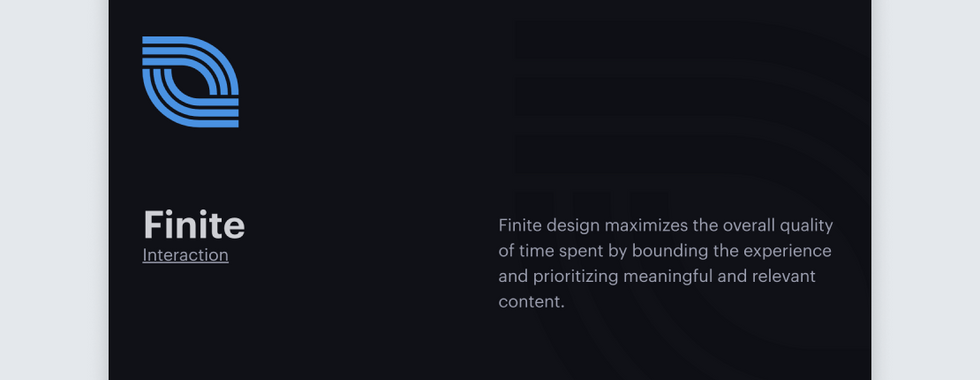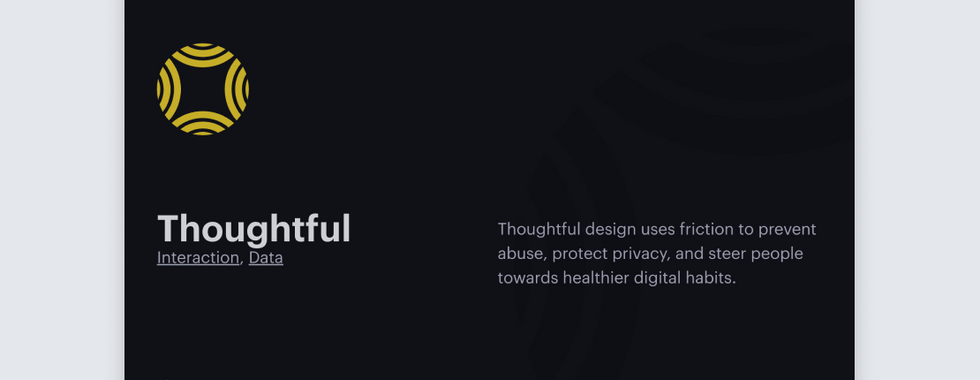Doomscrolling wasn't an accident. It was a UX decision.
As a web designer (and modern-day human), you know what we’re talking about: the practice of endlessly scrolling in search of good news, until your eyes glaze over and you’ve spent more time in front of a screen than you meant to. That practice was enabled by the infinite scroll, and that was enabled by UX design.
Jon Yablonski, a Detroit-based UX designer and senior product designer at MixPanel, recently launched “Humane by Design,” a part manifesto-part online hub of design resources, principles, and guidance to help UX designers counter long standing principles (like infinite scroll) and build a more humane internet.
Here, Yablonski explores what more humane design looks like, how it’s different from the “user-centered” design approaches we see in the industry today, and why the metrics of what qualifies “good design” need to shift.

The seven Humane by Design principles: empowering, finite, inclusive, resilient, respectful, thoughtful, and transparent. Image courtesy Jon Yablonski.
Shaping Design: How did this project come about?
Jon YabIonski: I created a website a while back called “Laws of UX,” and it expanded on this intersection of psychology and user experience design. At the time, a lot of conversation around this was that designers can’t do much. The underlying business model was the problem. It’s ads or data tracking, and all these things that are outside the purview of what designers focus on.
But I disagree with that. Designers can have an impact, and shape how technology affects people and empowers them. So I created a resource that tackled that head on and looked at high level considerations that designers could follow to create more ethically humane digital products and services.
Designers talk a lot about products being “user centered” or “human centered.” How is a focus on “user well-being,” as described within this framework, different?
JY: What you’ve seen happen, specifically in the digital product space, is that at some point we started to conflate human-centered design with business-centered goals. This is a natural evolution that teams go through. Companies start off centered around creating value for human beings. Then, over time, the company or startup grows; it’s acquired, and a shift starts to happen to be more focused on growth and business needs. “Humane by design” is trying to get back to that focus on the user, and designers being the advocate or surrogate for the user on these product teams.
What people want is technology to empower them: amplifying their abilities, making their life easier. The reality is that many products and services out there—even the ones that are renowned for being really well designed—sometimes use exploitative practices that monopolize people’s time and attention, and prioritize business goals over human goals.
Where are you seeing this?
JY: Social media is probably the most extreme example. Even features as ubiquitous as the “like” button on Facebook. This was a little mechanism that started as a means to spread positivity on the platform, and it's evolved to where you’ll find an equivalent to the “like'' button on every social media platform you’re on.
Today, research is catching up and we’re realizing that some of the most susceptible within our society, like young teenagers who are still forming their identity, are heavily affected by these little bits of social affirmation sprinkled throughout the apps and products that they’re using.
Humane design principles. Images courtesy Jon Yablonski.
You list seven humane design principles on the site. How did you land on these?
JY: It was a process of leveraging the experience I have as a designer and seeing patterns over the years, as well as taking a deep look at what kinds of apps and services people are talking about, and spending a lot of time thinking about that in the context of the original visions of the internet.
I’m thinking back to Mark Weiser, Larry Tesler, and Xerox Parc, and what they envisioned the internet could enable people to do, comparing that to where we are now, and identifying where the delta is. Looking at those patterns helped me narrow in on what we could do to better align with that vision of the internet, and what technology could do to empower people.
You write that the empowering design principle “ensures products center on the value they provide to people over the revenue it can generate.” How is this different from what we often see in UX design today?
JY: The empowering principle is all about getting back to human-centered design. More often, business needs start to trump human needs, and that becomes a problem in a lot of the products and services that we’re using.
An example of this could be small mechanics, like an autoplay video. Binge watching whole seasons of shows on Netflix isn’t necessarily getting people closer to their goals, or their capabilities as humans—and that was the original vision of what the internet could do. “Empowering” is about giving that power back to the human being, and enabling the user to make conscious decisions about how they choose to let technology shape their own behavior.
Humane design principles. Images courtesy Jon Yablonski.
Features like autoplay have also proven to be easily monetized. So does humane design need to be incentivized to be widely adopted?
JY: Yes, but the catch is that users themselves are starting to value and demand products that prioritize their time and attention. There’s a reason you’re starting to see browsers like Duck Duck Go, and alternative search engines to Google, that are focused on privacy, come up, and people leaving platforms like Facebook all together because of privacy concerns.
The pendulum has swung in the other direction, and people are realizing that when they use products and services that on the surface are free and easy to use, ultimately, there’s a tradeoff in terms of their time, attention, and privacy.
Humane design principles. Images courtesy Jon Yablonski.
What are some strong humane design examples UX designers can look to?
Apple is a really good one. Apple is notorious for placing a lot of emphasis around data privacy. When they are required by the government, for example, to handover personal user information, they disclose how often that happens on their website.
Microsoft’s windows operating system gives users fine range control over notifications, like when and how you’ll be notified by your operating system when an event occurs. This is an example of a really great pattern that they enable.
There’s lots of really good examples out there. The challenge is that there aren’t many companies, if any, that are getting it right across the board. They’re doing some good things and some bad things.
Top creative directors share their best practices.
Microsoft chief accessibility officer Jenny Lay-Flurrie
Sunday Afternoon creative director Rich Tu
Executive director of the Inneract Project Maurice Woods
Google head of product inclusion Annie Jean-Baptiste
Chair of the BFA design program at SVA Gail Anderson
What are some practical ways designers can introduce this into their own practice, especially if they work within the larger ecosystem of an agency or corporation?
The biggest thing that UX and web designers can do is introduce a lot more qualitative research. That means talking with people. Talk with your users and learn firsthand from them how the products, services, and features you’re creating affect them and how they potentially provide or don’t provide value for their lives.
Designers also need to be able to speak to stakeholders in their language. And more often than not, the language of stakeholders is the language of business. It’s a reminder that, as designers, we’re advocates for the user, and when users aren’t finding value in the products and services that they’re encountering, they’re going to abandon them and go to the competitor. From a business standpoint, that’s bad. That means a loss in users and revenue.
So speaking that language and being able to prioritize people over business goals is ultimately better for business in the long run. Designers need to advocate for that.


























